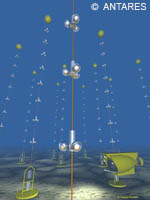Standing at the bottom of the sea but looking at the stars
Work on new type of telescope that will be used to detect the most elusive and mysterious of subatomic particles - neutrinos - has started the design phase, thanks to funding under the Sixth Framework Programme (FP6). The KM3Net project aims to 'build' a telescope around one kilometre square of water in the depths of the Mediterranean Sea, deep enough to be in complete darkness. This cube of water will be closely monitored, and act as a telescope, and will be used to find neutrinos. These particles pass through the earth in huge numbers at all times of the day and night - billions per day. However, these particles are extremely difficult to detect because they simply pass through everything that they come into contact with. Their mass is virtually zero and observation relies on a neutrino colliding with a water molecule in a water tanks. The collision emits a tiny quantity of light, which can be observed. 'Neutrinos are the closest thing to nothing you can study,' said Dr Lee Thompson of Sheffield University, a partner in the project, in an interview with The Observer newspaper. 'Unlike light - which is often blocked or obscured as it travels through space - neutrinos pass through everything: stars, planets, people, you name it. That makes them an amazingly rich source of information about the distant universe. The only problem is that they tend to pass through telescopes and detectors as well.' CORDIS news spoke to Professor Ulrich Ferdinand Katz, the project coordinator, from the Friedrich-Alexander University in Erlangen, Germany. 'The design study began on 1 February. We have organised the project into nine different work packages, which relate to areas ranging from system engineering and analysis to political issues. The goal is to develop the technology, and present the design report in 2009. Then we should expect around two years for the preparatory stage and engineering work. The project could be complete as early as 2010, with the first results around 2011,' he said. The KM3Net consortium is very wide, taking in 24 partners across France, Greece, Spain, Italy, the Netherlands, Cyprus and the UK. FP6 provides 9 million euro of the 17.5 million euro budget. The KM3Tec study relies on the results from three previous studies - the NESTOR deep sea telescope off the Greek coast, the ANTARES deep sea project off Toulon in France, and the NEMO site off southern Sicily, Italy. All these projects have pioneered the techniques required to make the KM3Net project work, and are candidate sites for the KM3Net project itself. The finished telescope will be a series of light detectors anchored to the bottom of the sea, filling a square kilometre. As there is no way to predict where a neutrino will collide with a water molecule, the large size of the project maximises potential sightings. A sister site is planned in the frozen Antarctic, to be built by an American consortium. Neutrinos detected at either or both sites will be cross-referenced with traditional astronomical data to find out what the neutrinos have come from. For example, large quantities of neutrinos are emitted just prior to supernovae, so flurries of detections could reveal a great deal about the essential nature of these distant events. 'The two machines will be able to study, simultaneously, the skies over both the northern and southern hemispheres,' Professor Katz told The Observer. 'For example, we know that at the heart of all galaxies there are huge black holes - collapsed stars that are soaking up matter like sponges. We cannot see them because they are surrounded by dust and debris. But soon we will be able to study them from the neutrinos they emit.'
Countries
Cyprus, Germany, Greece, Spain, France, Italy, United Kingdom



